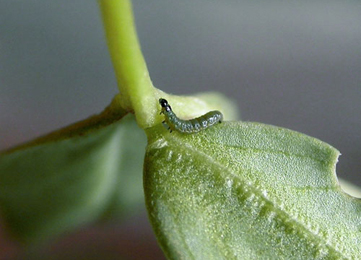|
||||||
|
OXYTROPIS. Milk-vetches. [Fabaceae] |
|
Two species of Oxytropis, Yellow Milk-vetch (O. campestris) and Mountain Milk-vetch (O. halleri) are recorded in Britain. Both are native species. Four British miners are recorded on Oxytropis. A key to the European miners recorded on Oxytropis is provided in Bladmineerders van Europa. |
|
Key for the identification of the known mines of British |
1a > Leaf-miner and case-bearer: The initial mine is like that of a nepticulid. The case is made form excised leaf portions, which are added to the oral end, leading to the ringed appearance. The larva causes the leaf to have white blotches. Identification cannot be made on these alone as similar blotches can be made by early instar larvae of the Common Blue butterfly (Polyommatus icarus). Oviposition at the leaf underside, mostly in a vein axil. The larva begins by making a narrow winding corridor with much frass in a broad central line. The corridor reminds that of a nepticulid (but the egg has a finely reticulate surface, unlike the smooth nepticulid egg.) In the end the corridor widens into an oval blotch, usually close to the leaf margin, out of which the first case is made. The full grown larva in a greyish brown composite leaf case of about 6 mm, attached to the underside of a leaf. The oldest quarter of the case is bivalved, laterally compressed, and is at an angle of 70° with the anterior part of the case. The mouth angle is around 40°. |
|
Coleophora discordella Zeller, 1849 [Lepidoptera: Coleophoridae]. |
1b > Leaf-miner: A short, irregular, linear upper surface mine on any part of the leaf. Also recorded from young pods (Bland, 1997a). Long corridor mine. As a rule the first part of the mine is lower-surface, the later part upper-surface. Often the loops are so dense that a secondary blotch is the result. Because upper- and lower-surface corridor segments often cross, the mine obtains a strange array of transparant patches. There is no association with the midrib. Frass in strings and thread fragments. Pupation outside the mine; exit slit in upper epidermis. Mine not associated with the veins or midrib of the leaf (It is this character which enables distinction from another Agromyzid pest species - Liriomyza huidobriensis). The larvae may leave one leaf (if not large enough) and enter another leaf, via the petiole). It exits the leaf to pupate through a semi-circular slit in the upper surface of the leaf. |
|
| Liriomyza bryoniae (Kaltenbach, 1858) [Diptera: Agromyzidae]. |
| 1c > Leaf-miner: A
narrow linear mine adjoining the leaf margin in the first instar,
which later develops into an irregular blotch with conspicuous lumps
of greenish frass (Spencer, 1976:
302).
The first instar larva makes a narrow upper-surface corridor along the leaf margin. After it has moulted it begins a large upper-surface blotch. Frass in conspicuous green lumps, that can run out irregularly. Pupation outside the mine. Forms a narrow linear mine by the margin of the leaf which later develops into a blotch. The blotch has clumps of greenish frass. |
|
Phytoliriomyza variegata (Meigen, 1830) [Diptera: Agromyzidae]. |
1d > Leaf-miner: The first generation initially forms an unmistakable leaf-mine on Anthyllis vulneraria, but the second generation feeds on the flowers. Feeding signs on other plants vary in appearance. Larvae can move between sewn leaves, and more than one larva may be found together. Larvae in a small full depth blotch, often with extensions. Frass concentrated in one corner of the mine. The mining activities may cause the leaf to roll inwards. Older larvae live free among spun leaves, but still they may make then full depth mines by feeding on the leaf tissue from a small opening. |
 Aproaerema anthyllidella larva, dorsal Image: © Steve Wullaert (Bladmineerders van Europa) |
|
Aproaerema anthyllidella (Hübner, 1813) [Lepidoptera: Gelechiidae]. |
| Last updated 06-Jul-2019 Brian Pitkin | ||
